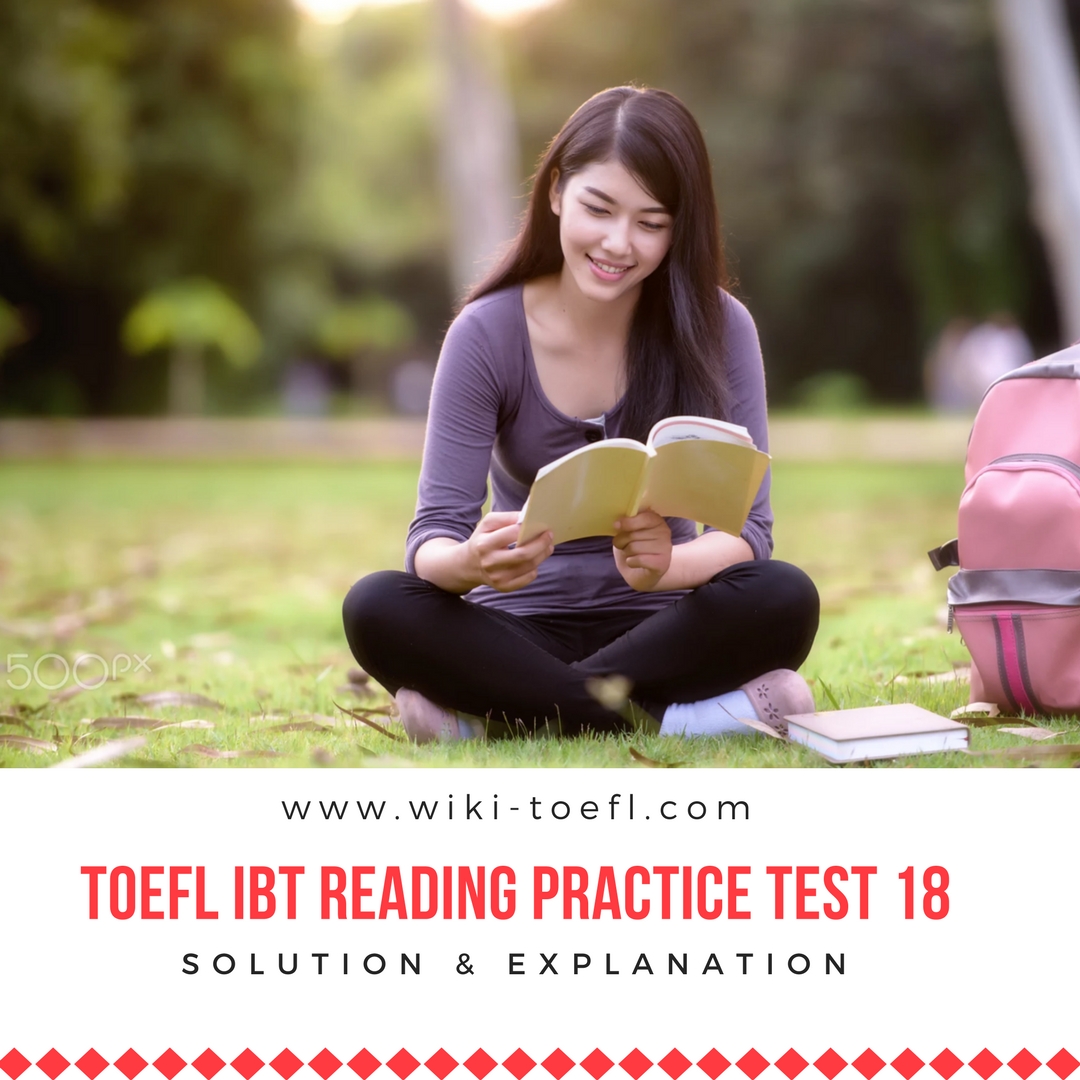Solution & Explanation for TOEFL iBT Reading Practice Test 18 ( From Barron’s TOEFL’S iBT)
Reading 1 “Rising Sea Levels”
1. B In this passage, scale is a synonym for “range.” Context comes from the numbers in the following sentence, .. 10-20 cm____”
2. B In this passage, probably is a synonym for “likely.”
3. B The author mentions an iceberg “the size of Delaware” to impress the reader with the size of the icebergs. Choices A, C, and D are not noted in the reference to Delaware.
4. D “In response to the increasing warmth, the Antarctic Peninsula is sporting new vegetation growth.” Choices A and C are true, but they are not the reason for the new plant life. Choice B is not correct because the islands have appeared because of ice melt, not because the land masses have split.
5. B “About 8000 km of ice shelf are gone, changing maps, freeing up islands to circumnavigation, and creating thousands of icebergs.” Choice A is not correct because a rise in temperature breaks an ice shelf into icebergs. Choice C is not correct because the reference to islands relates to warmer temperatures and melting ice. Choice D is not correct because mountain glaciers that melt will cause a rise in sea level, not the creation of icebergs.
6. B Most of paragraph 5 is in quotation marks in reference to data in a study by the IPCC. Choice A is not correct because the author is quoting data from a source. Choice C is not correct because data on sea levels does not compare one area with another. Choice D is not correct because the author does not mention his studies when he is presenting the data.
7. A In this passage, definite is a synonym for “conclusive.” Context comes from the phrase “the clearest and best evidence” in the following sentence.
8. A The IPCC did not have the data paraphrases “… the new measurements… did not reach the IPCC.”
9. C “… people move away from coastal flooding from the sea-level rise.” Choice A is not correct
because the temperature on land is not mentioned. Choice B is not correct because the vegetation along the coastlines will die as seawater floods it. Choice D is true, but it is not the reason why people will migrate.
10. C The reference to “Particularly tragic social and economic consequences” in the last paragraph
gives an insight into the author’s opinion. Choices A and B are not correct because they are not directly expressed and cannot be concluded from information in the passage. Choice D is not correct because the breaking up of ice shelves and the melting of ice causes the sea levels to rise, not the new glaciers that are created when the ice shelves disintegrate.
11. D … small island states … among the impacts there [in the states].” Choices A, B, and C refer
to consequences, not to the location.
12. B Alphabetical order is a transitional device that connects the sentences. Larsen A, B, and C are
mentioned in order. The insert sentence is an introductory statement.
13. C, B, E summarize the passage. Choice A is an example that supports major point C. Choice D is a detail that supports major point B. Choice F is an example that supports major point C.
Reading 2 “Organic Architecture”
14. C “One of the most striking personalities in the development of early-twentieth-century architecture was Frank Lloyd Wright____Wright set out to create ‘architecture of democracy.’” Choices
A, B, and D are major points that support the main idea, the work of Frank Lloyd Wright.
15. C According to a quote by Wright, “This ideal [organic unity]… I called … continuity.” Choice A is not correct because it refers to classical architecture, not to organic architecture. Choice B is not correct because, although he considered organic architecture his ideal, he referred to it as “continuity.” Choice D is not correct because Wright rejected classic architecture.
16. A “Wright manifested his vigorous originality early, and by 1900 he had arrived at a style entirely his own [style].” The phrase “his own” does not refer to Choices B, C, or D.
17. C In this passage, created is a synonym for “conceived.” Context comes from the word “designed” in the previous sentence.
18. D In this passage, Discontinuing is a synonym for “Abandoning.” Context comes from the contrast of “symmetry” with the “spaces… grouped freely.”
19. B “Wright fully expressed these elements and concepts in Robie House.” Choice A is true but it is only orie of the original ideas expressed. Choice C is not correct because, although it is often true of Wright1 s designs, the accessories for Robie House were not mentioned in the passage. Choice D is not correct because the house was built between 1907 and 1909, but Wright did not live there during the construction.
20. A In this passage, the phrase most important describes “prime.” The word “prime” is often used with “example.”
21. C Because “the city lot constrained the building-to-site relationship” at “Robie House,” the
description of “Fallingwater” implies that it was better suited to the site. Choice A is not correct because “Fallingwater” was built after “Robie House.” Choice B is not correct because “Falling-water” extended the “Robie House” design in all four directions. Choice D is not correct because “Robie House” had many large and open spaces in the “wandering” floor plan.
22. B “.. . he acted on a cherished dream to provide good architectural design for less prosperous
people by adapting the ideas of his prairie house to plans for smaller, less expensive dwellings.” Choice A is not correct because the smaller, prairie houses were not designed specifically for Europe. Choice C is not correct because many younger architects adopted his designs, but he did not build prairie houses to help architects. The revolution in architecture mentioned in Choice D occurred, but it was not Wright’s purpose in building the smaller versions of his prairie designs.
23. A “The publication of Wright1 s plans brought him a measure of fame in Europe… and an exhibition of his designs [in Berlin]. . . stimulated younger architects to adopt some of his ideas.” Choice B is not correct because lectures are not mentioned in the passage. Choices C and D are correct, but they are not the reasons that Wright’s work became well known in Europe.
24. C The entrance in a prairie house was “all but concealed.” Choice A is mentioned in paragraph 3, sentence 5. Choice B is mentioned in paragraph 3, sentence 7. Choice D is mentioned in paragraph 3, sentence 7.
25. B A general statement followed by examples is’a transitional device that connects the insert sentence with the following sentences. The insert sentence introduces the examples of the relationship between interior and exterior spaces.
26. C, F, D summarize the passage. Choices A, B, and E are details of Wrighfs professional life that are not main points in the passage.
Reading 3 “New Women of the Ice Age”
27. B “Amassing critical and previously overlooked evidence . . . Softer [proposes] a technique of hunting previously invisible in the archaeological evidence.” Choice A is not correct because her theories “make her conservative colleagues cringe.” Choice C is not correct because conservative researchers concentrated on studies of tools and bones and used them to support their theories. Choice D is not correct because she uses not only modem cultural evidence but also archeological evidence, including small game bones and tools that could have been used to make nets.
28. B “Amassing … evidence from Dolni Vestonice and the neighboring site of Pavlov, researchers… propose that human survival there had little to do with men hurling spears at big game animals. Instead … it [survival] depended largely on women, plants, and a technique of hunting previously invisible in the archeological evidence.” The pronoun “it” does not refer to Choices A, C, or D.
29. C In this passage, suggestions is a synonym for “implications.” Context comes from the clause “they raise serious questions” in the same sentence-
30. B Because her views “make her conservative colleagues cringe,” it must be concluded that her views are not as conservative. Choice A is not correct because she disagrees about the role of women as hunters, not as caretakers. Choice C is not correct because she is identified as an authority on the Ice Age and as an archeologist, not as a biologist. Choice D is not correct because she is a leading authority on hunting and gathering in the Ice Age.
31. A In this passage, limit is a synonym for “constrain.” Context comes from the logical supposition in the same sentence.
32. D … historically paraphrases “In many historical societies” and not perilous paraphrases “nor… in physical peril.” …did not require great strength paraphrases “did not call for brute strength,” and women have been important participants paraphrases “women played a key part.”
33. D “‘Everybody and their mother could participate [in net hunting].’” Choice A is not correct because the Australian hunters were not fishermen, and there is no evidence that they developed it. Choice B is not correct because net hunting did not place young mothers in physical peril. Choice C is not correct because net hunting was used to capture game, not to protect the camp.
34. A The author mentions Native American and Aborigine groups to give examples of modem groups in which women participate in net hunting. Choice B is not correct because the author presents facts, not opinions. Choice C is not correct because the techniques do not place women in peril but they do not protect them, either. Choice D is not correct because the example of the people in the Congo reinforces the information about the Native American and Aborigine groups.
35. C “. . . Mbuti in the forests of the Congo report that they capture game every time they lay out their woven traps, scooping up 50 percent of the animals encountered.” Choice A is not correct because nets are valued more than bows and arrows. Choice B is not correct because they trade the surplus meat with neighbors. Choice D is not correct because vegetables are not mentioned.
36. B “… some of their inhabitants whittled bone tools that look much like the awls and net spacers…” Choice A is true but it is not mentioned as evidence. Choice C is not correct because Softer believes that net hunting was more widespread than these two sites. Choice D is not correct because the camps stretched from Germany to Russia, but the researchers from those areas were not mentioned.
37. D In this passage, functions is a synonym for “roles.” Context comes from the reference to “activities” in the same sentence.
38. C A conclusion based on evidence is a transitional device that connects the conclusion in the insert sentence to the evidence in the previous sentences. Choices A and B are not correct because the conclusion in the insert sentence would appear before the evidence. Choice D is not correct because the insert sentence would interrupt the relationship between the first and second sentences in the last paragraph.
39. B, D, F summarize the passage. Choice A is a minor point that is not developed. Choice C is a detail that is mentioned to support major point D. Choice E is true, but it is not mentioned in the passage.

